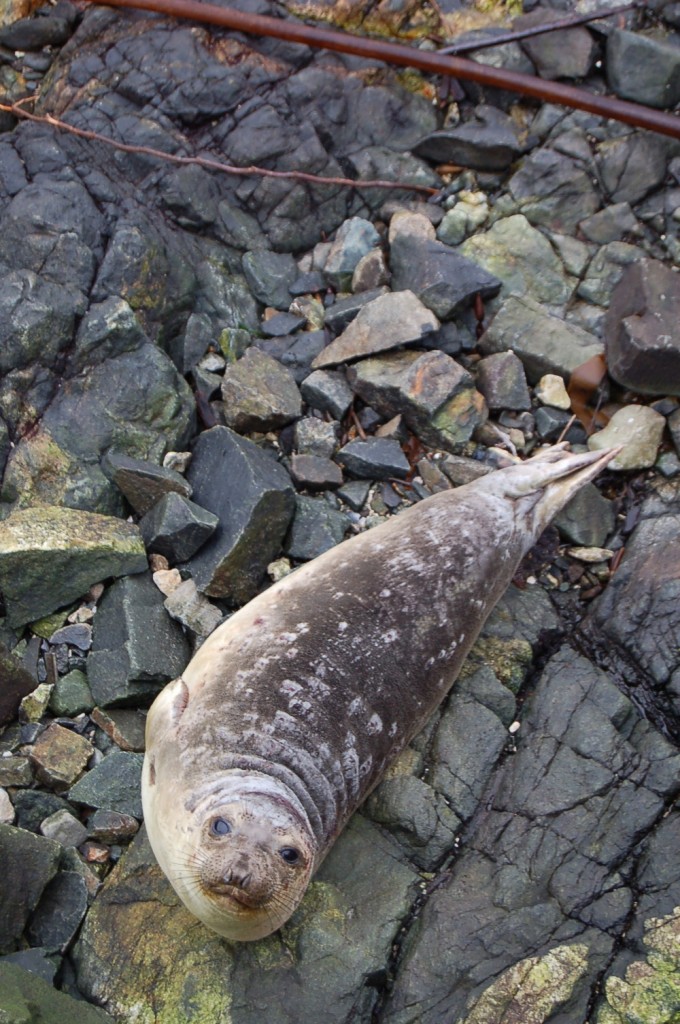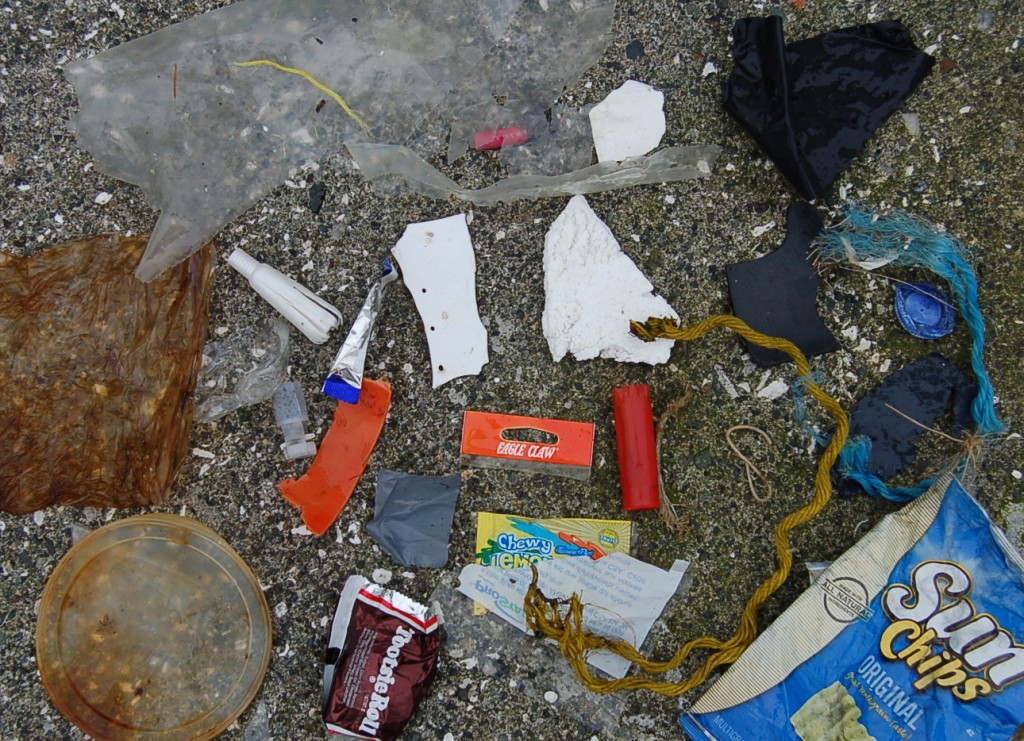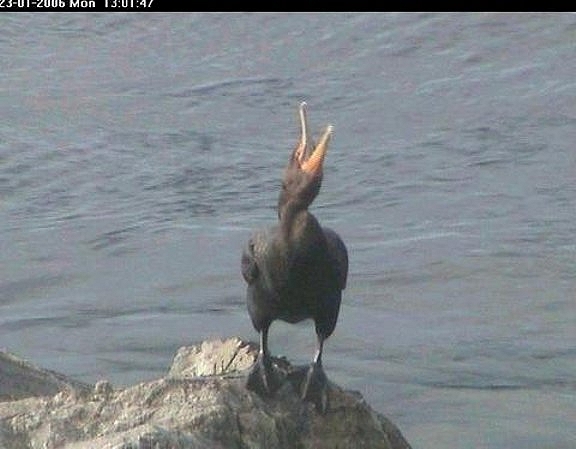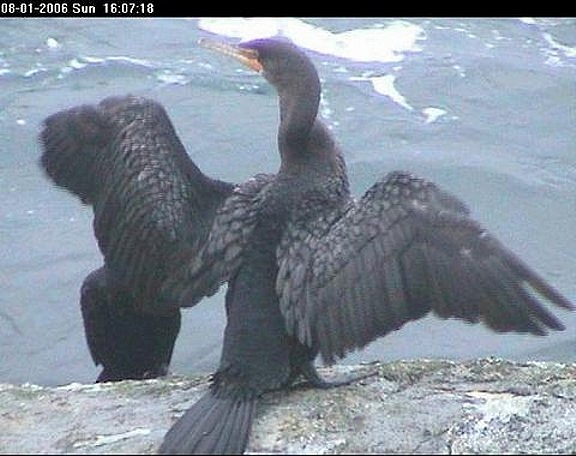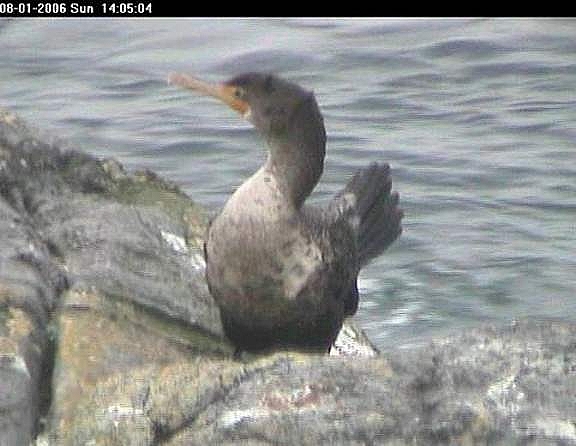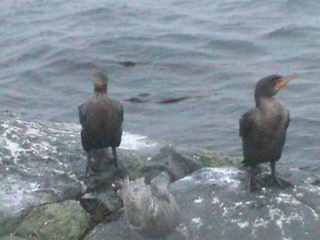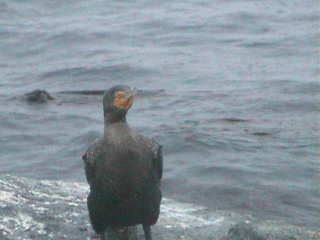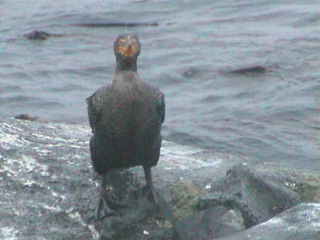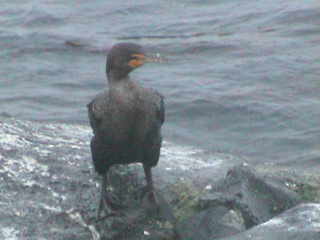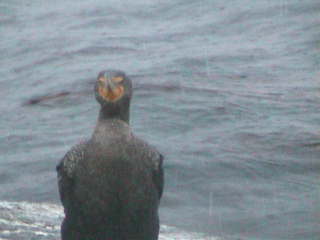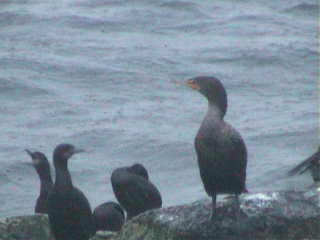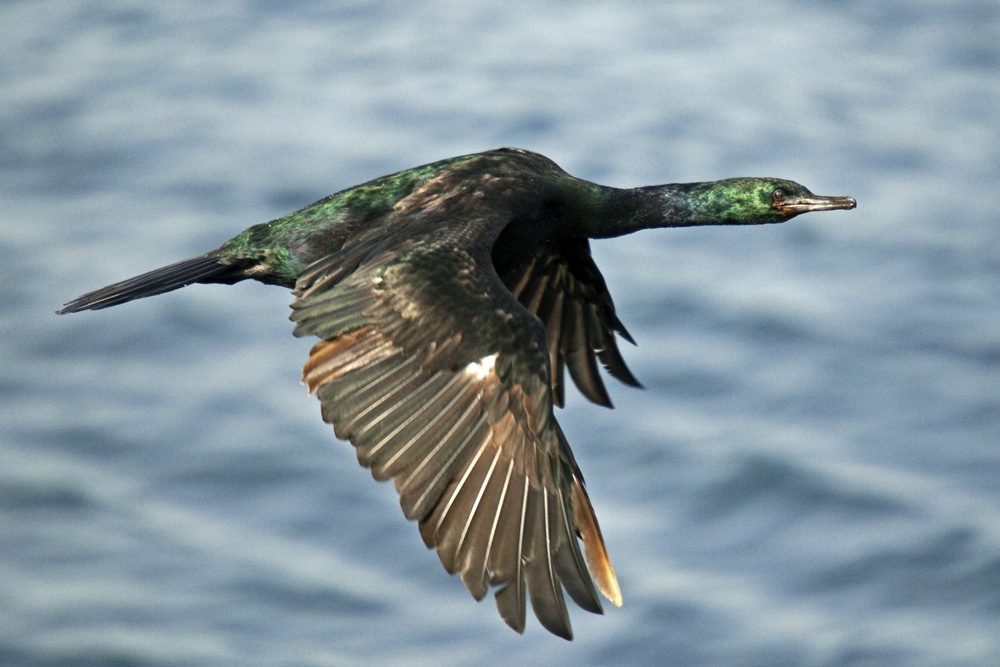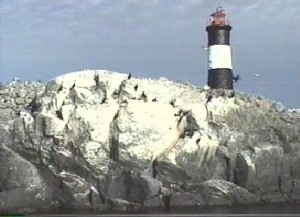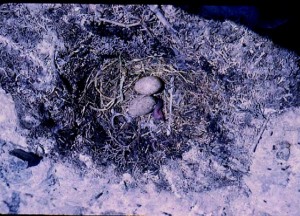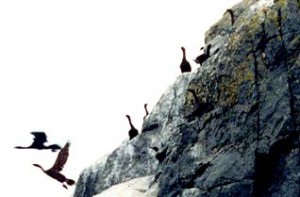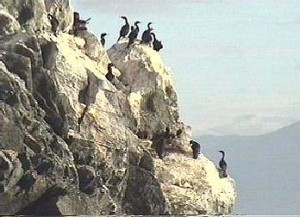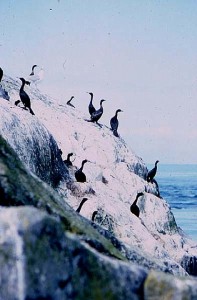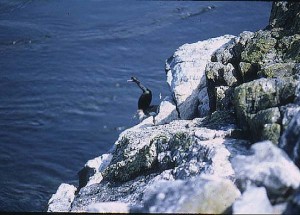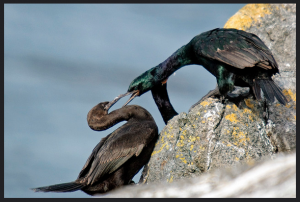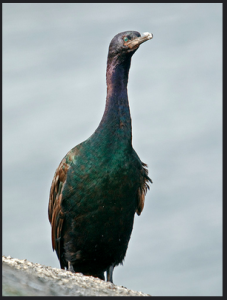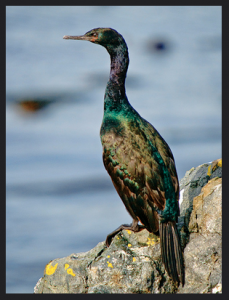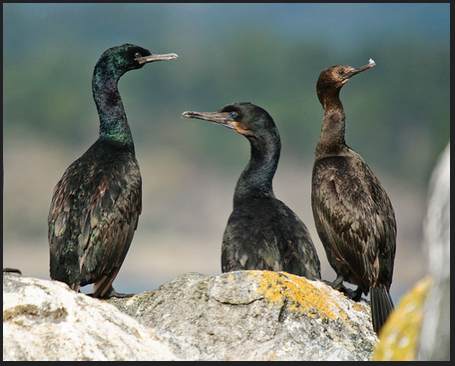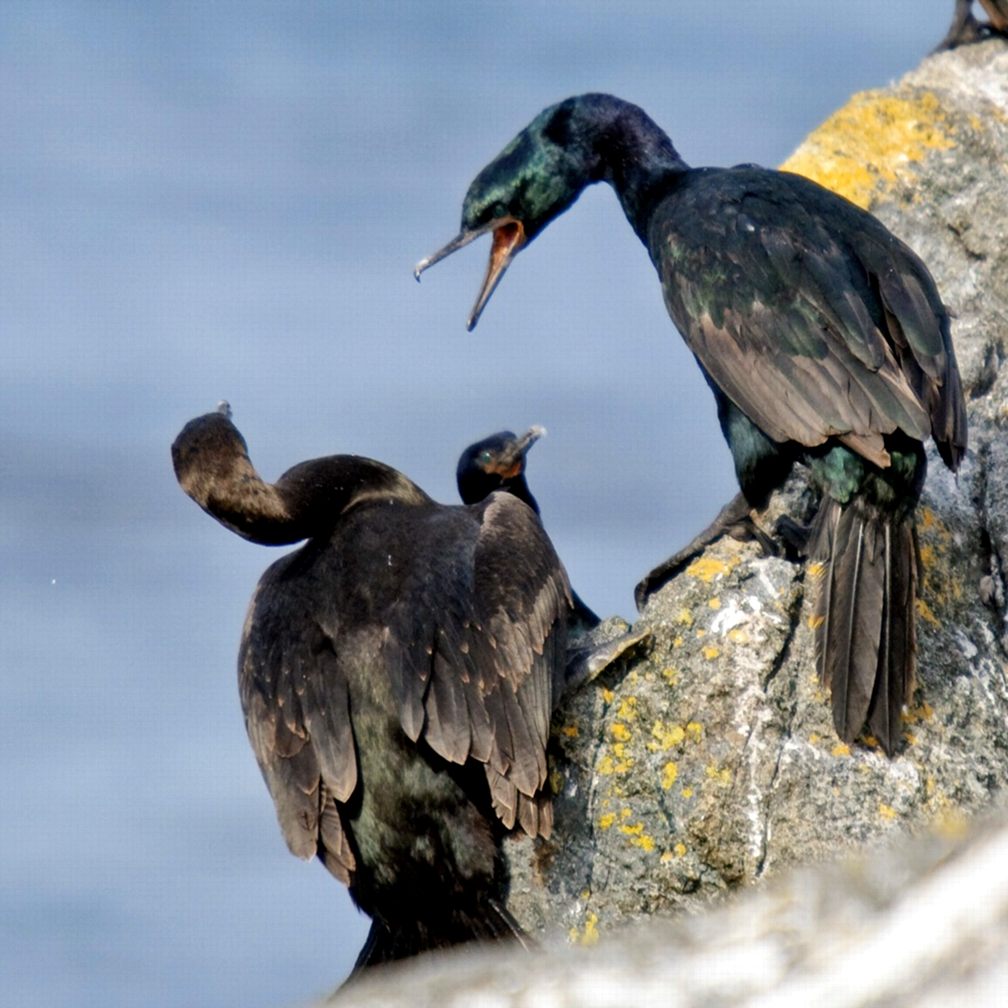 We have seen a marked decline in nesting of one of the four species of seabirds which has nested traditionally at Race Rocks, Pelagic Cormorants (Phalacrocorax pelagicus). By 2007, the nesting population had been reduced to one or two nests, and from 2008 to the last season (2009 ) there were no nests at all. This population crash has been common across the Gulf Islands., and the lower end of Vancouver Island and Strait of Juan de Fuca. According to the Canadian Wildlife Service, the population of this species is estimated to be at 9000 individuals, and the pelagicus subspecies is red-listed by BC – other subspecies are stable.
We have seen a marked decline in nesting of one of the four species of seabirds which has nested traditionally at Race Rocks, Pelagic Cormorants (Phalacrocorax pelagicus). By 2007, the nesting population had been reduced to one or two nests, and from 2008 to the last season (2009 ) there were no nests at all. This population crash has been common across the Gulf Islands., and the lower end of Vancouver Island and Strait of Juan de Fuca. According to the Canadian Wildlife Service, the population of this species is estimated to be at 9000 individuals, and the pelagicus subspecies is red-listed by BC – other subspecies are stable.
In this file, I have summarized the results of several papers on research on Cormorant populations in the southern Gulf Islands and Georgia Strait. Vermeer and Rankin, 1984, did their research when the populations were on the incline, however since the 1900s, this trend has not persisted as has been reflected in the paper by Chatwin et al. The summary of their paper and the possible reasons for decline are listed near the end of this review.
The British Columbia Coastal Waterbird Survey by Badzinski et al, 2005 indicated a possible upturn in the population trend in BC.
See images of Pelagic Cormorants on Ryan Murphy’s Flickr site
The Christmas bird count records from Race Rocks reflect some of the low population numbers at that time of year, but do show an increase in the last two years, so we hope this may signify a turn in the welfare of this species. It will be interesting to track whether or not this species returns to nesting.
Population Trends in Nesting Double-Crested and Pelagic Cormorants in Canada
- Author(s): Kees Vermeer and Leo Rankin Source: The Murrelet, Vol. 65, No. 1 (Spring, 1984), pp. 1-9 Published by: Society for Northwestern Vertebrate Biology Stable URL: http://www.jstor.org/stable/3534203 (partial listing only)
- ABSTRACT- Breeding populations of Double-crested (Phalacrocorax auritus) and Pelagic Cormorants (P. pelagicus) were surveyed in the Strait of Georgia, British Colum-bia, in 1983. Double-crested Cormorant numbers have increased 2.4-fold and Pelagic Cormorant numbers 1.1-fold since 1975. Double-crested Cormorant populations are presently not only increasing in British Columbia but all across Canada and in the northeastern United States. These increases are thought to be the result of decreased disturbance and persecution by man.
- The following table is presented in partial form only:

|
Double-crested and Pelagic Cormorant Inventory in the Strait of Georgia in 2000
- http://www.env.gov.bc.ca/wildlife/wsi/reports/4382_WSI_4382_RPT.PDF (see complete report)
Authors:Trudy A. Chatwin, Monica H. Mather, Tanya Giesbrecht May 2001
Abstract Since the early 1990’s Double-crested and Pelagic Cormorant have shown alarming declines in nesting populations in the Strait of Georgia. This study was initiated in 2000 to provide a complete count of nesting colonies in the Strait and compare population estimate from counts completed in various years since the mid 1950’s. A complete survey of all colonies was done in 1987. Before that, counts were done in many colonies, though not annually. We surveyed 34 Pelagic Cormorant and 17 Double-crested Cormorant historic and current colonies during the 2000 breeding season. Where possible we examined nest population trends at colonies with multiple years of data. Our analyses showed that overall counts of Pelagic Cormorants were down by half and Double-crested Cormorants had declined by two-thirds since 1987. Pelagic Cormorants showed a significant decline in total nests between 1959 and 2000; although during that period, an increase in the population at Mitlenatch Island was noted. At Double-crested Cormorant colonies, two significant increasing trends were noted. Since 1983 the population at Shoal Islands has slowly increased from zero to 104 nests in 2000. Likewise the population at Mitlenatch has also increased from zero to 70 nests. However these increases do not offset the very dramatic declines in overall population size. The most profound decreases were seen at Mandarte and Great Chain Islands where most of the Double-crested Cormorants were nesting in the late 1980’s. At Mandarte Island, 1100 nests were observed in 1983, while only to 215 were counted in 2000. We suggest that the causes of declines are possibly related to a combination of Bald Eagle disturbance, change in prey availability and human disturbance. Recommendations for management and conservation are discussed.
- The following table is presented in partial form only:

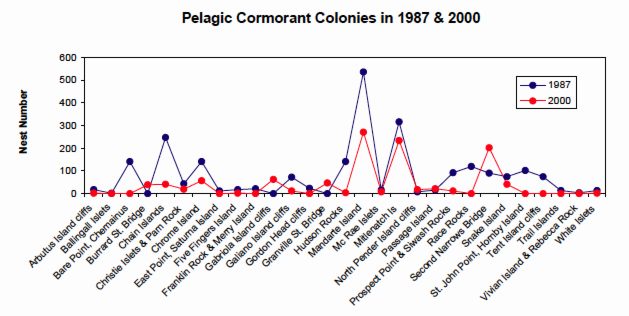
|
The authors express their concern for the decline in recent years with the following summation:
- “Based on nest counts, the nesting populations of Pelagic and Double-crested Cormorants in the Strait of Georgia have shown alarming declines in the last few years. Concern is especially warranted when one compares the complete counts that were made in 1987 and 2000. The number of nests observed has decreased by 54% for Pelagic and 70% for Double-crested Cormorants. “
|
The reasons for the decline were summarized in the paper as follows:
- “The populations of both cormorant species have fluctuated considerably over the 40 years of surveys. This could be due to changes in prey availability in the Strait. Cormorants feed on Pacific Herring, Gunnells, Shiner Perch and Salmon. It has been suggested that herring schools have moved north in the Strait of Georgia (Jane Watson, Pers. Comm.), which could account for the increase in both species of cormorants at Mitlenatch. However, this does not account for the loss of the Hornby Island Colony as there is a major herring spawn in that area. As well, it is difficult to explain the increase in the Shoal Islands Double-crested Cormorant colony, by shifts in herring populations.
Other concerns for nesting cormorants are predation by Bald Eagles (Haliaeetus leucocephalus) and disturbance from boat traffic. Eagle populations have increased on the east side of Vancouver Island (Karen Morrison, Pers. Comm.). Giesbrecht (2001) showed that Eagles were the main source of disturbance to nesting Double-crested Cormorant ’s in the Strait. She observed eagles flushing birds from their nests as well as direct predation on adults/juveniles. Recreational boating and kayaking have also increased in the Strait of Georgia. Although Giesbrecht (2001) did not observe flushing by boaters in her study, anecdotal information (Moul 2001) indicates that human disturbance either by landing at a colony or flushing birds by approaching too closely exposes chicks and eggs to predation by Northwestern Crows (Corvus caurinus), Glaucous-winged Gulls (Larus glaucescens) and Bald Eagles. “
|
| British Columbia Coastal Waterbird Survey An Evaluation of Survey Power and Species Trends after Five Years of Monitoring March 2005http://www.bsc-eoc.org/download/BCCWS%205-YR%20Report.pdf
Authors: Shannon S. Badzinski 1, Richard J. Cannings 2, Tasha Smith 2, & Jason Komaromi 3
- Data for two of three species of cormorants show increasing trends (Double-crested
Cormorant, Pelagic Cormorant). Both these species have shown significant declines in numbers
at breeding colonies on the British Columbia coast between 1980 and 2000, so the results from
this survey may indicate a stabilizing trend but further monitoring is clearly needed. Brandt’s
Cormorants, which occur primarily as a non breeding species, show no clear population trend
over the past 5 years.
|
| Also from the website of the Canadain WildlifeService, Information is presented on the decline of seabirds along the Pacific Coast of Canada. So we will continue to update our population observations of this species .Garry Fletcher, February, 2010 |

